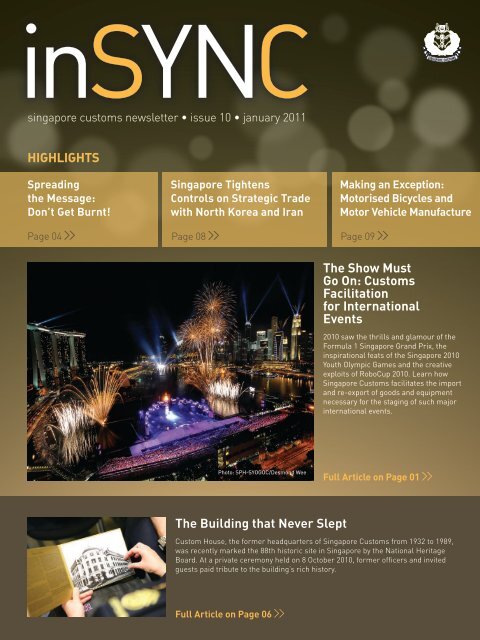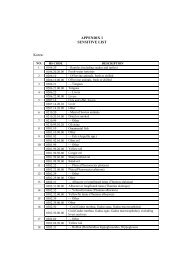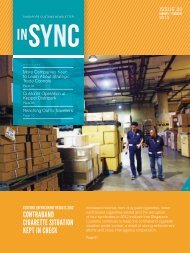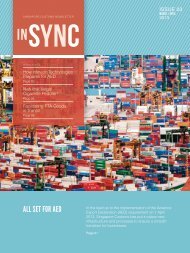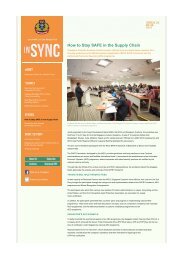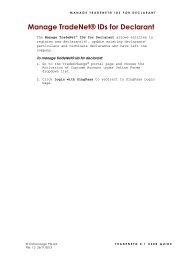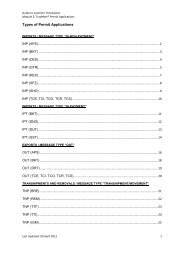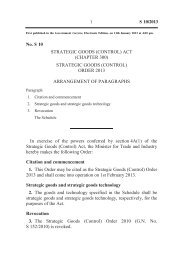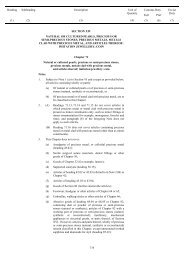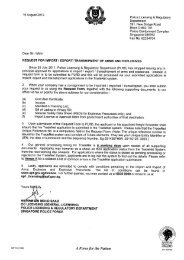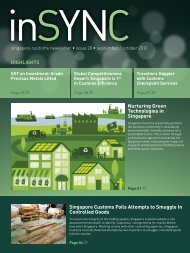Download PDF - Singapore Customs
Download PDF - Singapore Customs
Download PDF - Singapore Customs
You also want an ePaper? Increase the reach of your titles
YUMPU automatically turns print PDFs into web optimized ePapers that Google loves.
inSYNC<br />
FEATURES<br />
0I<br />
singapore customs newsletter • issue 10 • january 2011<br />
HIGHLIGHTS<br />
Spreading<br />
the Message:<br />
Don’t Get Burnt!<br />
<strong>Singapore</strong> Tightens<br />
Controls on Strategic Trade<br />
with North Korea and Iran<br />
Making an Exception:<br />
Motorised Bicycles and<br />
Motor Vehicle Manufacture<br />
Page 04 Page 08 Page 09<br />
The Show Must<br />
Go On: <strong>Customs</strong><br />
Facilitation<br />
for International<br />
Events<br />
2010 saw the thrills and glamour of the<br />
Formula 1 <strong>Singapore</strong> Grand Prix, the<br />
inspirational feats of the <strong>Singapore</strong> 2010<br />
Youth Olympic Games and the creative<br />
exploits of RoboCup 2010. Learn how<br />
<strong>Singapore</strong> <strong>Customs</strong> facilitates the import<br />
and re-export of goods and equipment<br />
necessary for the staging of such major<br />
international events.<br />
Photo: SPH-SYOGOC/Desmond Wee<br />
Full Article on Page 01<br />
The Building that Never Slept<br />
Custom House, the former headquarters of <strong>Singapore</strong> <strong>Customs</strong> from 1932 to 1989,<br />
was recently marked the 88th historic site in <strong>Singapore</strong> by the National Heritage<br />
Board. At a private ceremony held on 8 October 2010, former officers and invited<br />
guests paid tribute to the building’s rich history.<br />
Full Article on Page 06
0II<br />
CONTENTS<br />
FEATURES<br />
inSIGHT<br />
Welcome to the first issue of a new, revamped inSYNC and<br />
to the start of 2011. We would like to wish every one of you<br />
a warm and sincere Happy New Year.<br />
The launch of our inaugural issue during this period is<br />
no coincidence. The new year represents a time for new<br />
beginnings and change. <strong>Singapore</strong> <strong>Customs</strong> remains<br />
committed to providing the trading community with easy<br />
access to relevant news updates and engaging stories.<br />
Towards that end, inSYNC is now available as both a print and<br />
online edition, and has been redesigned with a fresh new look<br />
to enhance your reading experience.<br />
In this issue, take a look behind the scenes at <strong>Singapore</strong><br />
<strong>Customs</strong>’ facilitation of several major international events:<br />
the Formula 1 <strong>Singapore</strong> Grand Prix, the <strong>Singapore</strong> 2010<br />
Youth Olympic Games and RoboCup 2010. Meanwhile, our<br />
latest anti-contraband cigarette campaign is underway.<br />
Discover the creative range of media strategies put to use in<br />
getting the message out. Or learn more about the rich history<br />
of the Custom House building and <strong>Customs</strong>’ past as we bring<br />
you the unveiling of <strong>Singapore</strong>’s 88th historic site.<br />
For your convenience, we have also added a new regular<br />
feature at the end of each inSYNC issue: a calendar of<br />
the latest <strong>Customs</strong> training programmes and educational<br />
workshops.<br />
We hope you have a good read, and wish you all the best in<br />
the year ahead.<br />
PATRICIA BAY<br />
Editor<br />
01<br />
04<br />
06<br />
08<br />
09<br />
10<br />
11<br />
12<br />
13<br />
Features<br />
The Show Must Go On: <strong>Customs</strong> Facilitation<br />
for International Events<br />
Spreading the Message: Don’t Get Burnt!<br />
The Building that Never Slept<br />
Updates<br />
<strong>Singapore</strong> Tightens Controls on Strategic Trade<br />
with North Korea and Iran<br />
Making an Exception: Motorised Bicycles and<br />
Motor Vehicle Manufacture<br />
Easing Import GST Cashflow for Businesses<br />
Law Catches Up with Tax Cheats among<br />
Car Traders<br />
Inside <strong>Customs</strong><br />
Repositioning Trade Division for the Future<br />
Training Calendar<br />
Event Highlights<br />
Editorial team<br />
Patricia Bay (Editor) | Lynn Ng | Victor Seah<br />
DESIGN BY<br />
Green House Design + Communications<br />
Please let us know what you think of the new inSYNC.<br />
We welcome your ideas on what you would like to see<br />
and how we can do better. Write in to the Editor at<br />
customs_media@customs.gov.sg<br />
To read, download or subscribe to the online edition<br />
of inSYNC, please visit www.customs.gov.sg/insync<br />
InSYNC is a publication of <strong>Singapore</strong> <strong>Customs</strong>. Copyright of the<br />
materials contained in this publication belongs to <strong>Singapore</strong> <strong>Customs</strong>.<br />
Nothing in here shall be reproduced in whole or in part without<br />
prior written consent of <strong>Singapore</strong> <strong>Customs</strong>. All rights reserved.<br />
All information is correct at time of publication.
FEATURES<br />
01<br />
The Show Must Go On:<br />
<strong>Customs</strong> Facilitation<br />
for International Events<br />
2010 saw the thrills and glamour of the Formula 1 <strong>Singapore</strong> Grand Prix,<br />
the inspirational feats of the <strong>Singapore</strong> 2010 Youth Olympic Games and the<br />
creative exploits of RoboCup 2010. Learn how <strong>Singapore</strong> <strong>Customs</strong> facilitates<br />
the import and re-export of goods and equipment necessary for the staging of<br />
such major international events.<br />
As Formula 1 racing teams, footballkicking<br />
robots and aspiring youth athletes<br />
from around the world prepared to<br />
enter <strong>Singapore</strong> for their turn to shine<br />
in the international spotlight, <strong>Singapore</strong><br />
<strong>Customs</strong> worked a step ahead to ensure<br />
the smooth import and re-export of each<br />
event’s goods and cargoes.<br />
Hosting large-scale international events<br />
usually means bringing a significant<br />
amount of associated goods and cargo<br />
into the country. With imported goods<br />
usually requiring payment of duties and<br />
Goods & Services Tax (GST), <strong>Singapore</strong><br />
<strong>Customs</strong> has remained flexible by having<br />
in place the Temporary Import Scheme<br />
(TIS).<br />
With prior approval from the relevant<br />
<strong>Singapore</strong> authorities, goods under the<br />
TIS (with the exception of liquor and<br />
tobacco) are allowed to be brought in on<br />
a temporary basis for repairs and other<br />
purposes such as stage performances,<br />
testing or demonstration without<br />
incurring duties or GST. In general, these<br />
goods will have to be re-exported within<br />
three months from their date of import.<br />
There are times however, when the<br />
massive and complex scale of a major<br />
international event calls for additional<br />
facilitation and support beyond the TIS.<br />
BEFORE THE BIG RACE<br />
The safe and smooth entry of all 24<br />
Formula 1 (F1) racing cars marked just<br />
a fraction of the cargo brought in for the<br />
<strong>Singapore</strong> Grand Prix.<br />
Accompanying them were 41 BMW and<br />
Porsche high-performance cars for the<br />
event’s support races, over 2,000 tyres,<br />
spare parts, engines, nuts and bolts,<br />
as well as the various equipment and<br />
tools needed to maintain and repair<br />
the vehicles or for use at the race.<br />
Expendable items such as gasoline,<br />
engine oil, paint and aerosols also had<br />
to be accounted for, as did items related<br />
to the event’s promotions and sales<br />
including brochures, pamphlets and<br />
merchandise.<br />
F1 Cargo Factoid<br />
650 tonnes of air-freighted<br />
equipment and 150 tonnes of seafreighted<br />
equipment including:<br />
• 24 F1 racing cars<br />
• 18 BMW cars and 23 Porsche cars<br />
• 2640 tyres for all race cars
02<br />
FEATURES<br />
A member of the multi-agency F1 Traffic<br />
and Transport Sub-Committee chaired by<br />
the Land Transport Authority, <strong>Singapore</strong><br />
<strong>Customs</strong> has stepped up to facilitate the<br />
imports and re-exports of all cargoes for<br />
the past three F1 races in <strong>Singapore</strong>.<br />
Under the TIS, all F1 vehicles and<br />
authorised race equipment were allowed<br />
to be imported without payment of<br />
duties and GST. <strong>Singapore</strong> <strong>Customs</strong><br />
also worked closely with the race<br />
organisers and the two appointed freight<br />
handling agents, Mega-Air and Asian<br />
Groupage Services, to clarify customs<br />
documentation requirements and<br />
operational procedures, as well as to<br />
address feedback and concerns.<br />
Other measures taken to facilitate the<br />
speedy clearance of F1 cargoes included<br />
simplifying declarations, security<br />
lodgement requirements and checkpoint<br />
clearance procedures, and providing the<br />
appointed freight handling agents with a<br />
24/7 contact for urgent customs inquiries.<br />
Feedback from both the appointed<br />
agents has been positive. Said Ms Kris<br />
Teo, Import Manager for Asian Groupage<br />
Services, “Over these three years,<br />
<strong>Singapore</strong> <strong>Customs</strong> has been supportive<br />
with prompt action on the problems that<br />
we faced. We really appreciate the great<br />
help that makes this event successful<br />
every year.”<br />
Photo: <strong>Singapore</strong> Grand Prix<br />
The 2010 F1 <strong>Singapore</strong> Grand Prix<br />
was successfully held from 24 to 26<br />
September 2010.<br />
SEND IN THE ROBOTS<br />
Jointly organised by <strong>Singapore</strong><br />
Polytechnic (SP), Science Centre<br />
<strong>Singapore</strong>, the Economic Development<br />
Board (EDB) and supported by the<br />
Ministry of Education, RoboCup 2010 was<br />
an international event featuring robot<br />
competitions, workshops, exhibitions<br />
and conferences.<br />
The event took place for the first time<br />
in <strong>Singapore</strong> from 19 to 25 June 2010 at<br />
the Suntec International Convention and<br />
Exhibition Centre. With approximately<br />
3,500 participants from 42 countries, SP<br />
requested <strong>Singapore</strong> <strong>Customs</strong>’ assistance<br />
to facilitate the process of bringing the<br />
hundreds of robots into <strong>Singapore</strong>.<br />
Recognising the robots as equipment<br />
temporarily imported into <strong>Singapore</strong><br />
for the sole purpose of the competition,<br />
and also their non-commercial nature,<br />
<strong>Singapore</strong> <strong>Customs</strong> allowed the<br />
temporary import and granted GST relief<br />
for all the hand-carried robots under<br />
the TIS.<br />
Even under TIS, however, an inward<br />
permit would still need to be declared.<br />
Considering the large number of 500<br />
participating teams, <strong>Singapore</strong> <strong>Customs</strong><br />
offered to use a simplified document to<br />
better facilitate the process and to avoid<br />
having the teams pay extra to engage<br />
freight forwarders to take up the permit.<br />
RoboCup teams were only required<br />
to produce the simplified <strong>Singapore</strong><br />
<strong>Customs</strong> document, together with other<br />
documents from SP, for clearance by<br />
checkpoint officers. To ensure things<br />
went smoothly, <strong>Singapore</strong> <strong>Customs</strong> made<br />
it a point to communicate the RoboCupspecific<br />
clearance procedures to the<br />
checkpoints in advance.<br />
In a letter of appreciation, Mr Jonathan<br />
Kua, Director of EDB’s New Business<br />
Group, conveyed how all RoboCup<br />
participants had a good experience,<br />
with the President of RoboCup and the<br />
Trustees commenting that this was the<br />
best RoboCup thus far, and a hard one to<br />
beat for years to come.
FEATURES 03<br />
Peh Kay Koon (top), Michelle Chan (middle) and<br />
William Yen (bottom).<br />
HOLDING THE YOUTH<br />
OLYMPIC FLAME HIGH<br />
<strong>Singapore</strong> <strong>Customs</strong>’ own Peh<br />
Kay Koon, Michelle Chan and<br />
William Yen were among the 2,400<br />
torchbearers selected to take part<br />
in the 6-day torch relay of the Youth<br />
Olympic Flame around <strong>Singapore</strong>.<br />
Calling the opportunity a “once<br />
in a lifetime” experience, Mr Peh<br />
described the 100m distance<br />
as “the slowest and yet most<br />
memorable run” in his entire life.<br />
Ms Chan shared similar<br />
sentiments, recalling the “amazing,<br />
indescribable” feeling of running<br />
with the torch. “Memories of the<br />
short ‘one minute of fame’ will<br />
forever be etched in my mind,”<br />
she added.<br />
“By accomplishing this run, I hope<br />
I can inspire everyone in <strong>Singapore</strong><br />
<strong>Customs</strong> to embrace, embody<br />
and express the Olympic values<br />
of Excellence, Friendship and<br />
Respect,” said Mr Yen.<br />
BLAZING AN OLYMPIC TRAIL<br />
From giving inputs during the initial bid<br />
and planning phase in August 2007 to<br />
ensuring the smooth clearance of eventrelated<br />
cargo into <strong>Singapore</strong> three years<br />
later in August 2010, <strong>Singapore</strong> <strong>Customs</strong><br />
was involved the entire way as the country<br />
played host to the world’s first-ever Youth<br />
Olympic Games (YOG).<br />
To prepare for <strong>Singapore</strong>’s hosting of<br />
the YOG, the <strong>Singapore</strong> Youth Olympic<br />
Games Organising Committee formed<br />
nine working groups. <strong>Singapore</strong> <strong>Customs</strong><br />
co-chaired the Freight Forwarding &<br />
<strong>Customs</strong> Clearance Working Group<br />
and also played a role in the Arrival &<br />
Departure Operations Working Group.<br />
Establishing the duty and GST treatment<br />
for YOG goods and the customs<br />
procedures to authenticate the right<br />
goods for duty exemption and GST relief<br />
was only one part of <strong>Singapore</strong> <strong>Customs</strong>’<br />
efforts. There was the Freight Document<br />
and the Arrival and Department<br />
Document, comprehensive procedural<br />
guides that <strong>Singapore</strong> <strong>Customs</strong> helped<br />
draft to circulate to the National Olympic<br />
Committees.<br />
Mindful that importers and declaring<br />
agents might be confused when declaring<br />
YOG goods, <strong>Singapore</strong> <strong>Customs</strong> also<br />
went the extra mile in drawing up a<br />
table outlining seven broad scenarios for<br />
easy understanding. On the other end,<br />
<strong>Singapore</strong> <strong>Customs</strong> collaborated with<br />
various controlling agencies to make<br />
sure documentation procedures were<br />
streamlined and executed correctly.<br />
To expedite operations on the ground,<br />
<strong>Singapore</strong> <strong>Customs</strong> worked with the<br />
Inland Revenue Authority of <strong>Singapore</strong> to<br />
set up dedicated GST Refund Counters<br />
specifically for YOG officials and athletes<br />
at each Changi Airport terminal.<br />
No matter however small was<br />
overlooked, such as the liquor consumed<br />
during official YOG events. After<br />
several discussions with the organising<br />
committee, <strong>Singapore</strong> <strong>Customs</strong> devised<br />
a special procedure to track the liquor<br />
inventory, one which was convenient<br />
for the organisers to implement yet<br />
uncompromising on revenue risk.<br />
More prominent shipments for the YOG<br />
included torches for the torch relay,<br />
timing equipment for the sports events<br />
and official Olympic broadcasting<br />
equipment.<br />
A momentous undertaking, the<br />
successful YOG stands testament to<br />
the close coordination among <strong>Singapore</strong><br />
<strong>Customs</strong>’ various internal branches and<br />
their professional commitment.<br />
Photo: XINHUA/SYOGOC-Pool/Qi Heng
04<br />
FEATURES<br />
Spreading the Message:<br />
Don’t Get Burnt!<br />
Focusing on the consequences of dealing with illegal cigarettes, <strong>Singapore</strong><br />
<strong>Customs</strong>’ latest anti-contraband public outreach campaign “Don’t Get Burnt”<br />
employs a wide range of traditional and new media platforms as well as<br />
creative outreach strategies to reach greater levels of public awareness.<br />
Unadorned except for the iconic image<br />
of a cigarette burn mark, a mysterious<br />
truck roving around the island first<br />
made its appearance in August 2010,<br />
attracting attention and sparking curious<br />
discussions from netizens on STOMP and<br />
in the local newspapers.<br />
The truck’s full meaning was eventually<br />
unveiled when it was transformed into<br />
a full-fledged mobile roadshow stage at<br />
Causeway Point in October 2010 for the<br />
“Don’t Get Burnt” campaign roadshow<br />
launch, the latest in <strong>Singapore</strong> <strong>Customs</strong>’<br />
ongoing efforts against contraband<br />
cigarettes.<br />
A metaphor for the harmful<br />
consequences of dealing with illegal<br />
cigarettes, the campaign’s burn mark<br />
icon and tagline “Don’t Get Burnt” seek<br />
to warn the public about the dangers<br />
and stiff penalties for activities involving<br />
duty-unpaid cigarettes as well as to foster<br />
a greater sense of civic responsibility.<br />
Members of public are encouraged to<br />
report any illegal cigarette activities to<br />
avoid getting “burnt” by them.<br />
The second phase of the “Don’t Get Burnt” roving truck where more of the campaign is revealed (top) and a member of the<br />
public participating in the “Wheel of Knowledge” game at the campaign roadshow (bottom).<br />
Public outreach continues to be a key<br />
focus in <strong>Singapore</strong> <strong>Customs</strong>’ anticontraband<br />
efforts. “While we have<br />
achieved some success in eradicating<br />
illegal cigarettes, having the collective<br />
will from the public to say no to illegal<br />
cigarettes is the long-term sustainable<br />
solution to win this fight against illegal<br />
cigarettes,” said Mr Fong Yong Kian,<br />
Director-General of <strong>Singapore</strong> <strong>Customs</strong>.
FEATURES 05<br />
DRIVING HOME THE MESSAGE<br />
Doubling as both a fully-equipped<br />
stage and an exhibition area fitted with<br />
informative panels for the public to learn<br />
about the dangers of illegal cigarettes,<br />
the iconic “Don’t Get Burnt” truck is at<br />
the heart of the campaign’s series of 25<br />
public outreach roadshows, which ends<br />
in July 2011.<br />
Besides adding a more interesting<br />
dimension, the customised vehicle allows<br />
for greater mobility, giving the roadshows<br />
an even wider demographic reach with<br />
scheduled stops at polytechnics, student<br />
and foreign worker dormitories, and<br />
various heartland areas.<br />
Encouraged by positive feedback since<br />
their debut in 2009, these public outreach<br />
roadshows have been further enhanced<br />
to provide a conducive, interactive<br />
platform for <strong>Singapore</strong> <strong>Customs</strong> to<br />
engage with the community and to<br />
promote the campaign’s key messages<br />
on an individual basis.<br />
During the launch and subsequent<br />
roadshows, participants are invited to<br />
take part in educational games with the<br />
chance to win prizes. Fun activities such<br />
as “Wheel of Knowledge”, “Shoot and<br />
Win” and the familiar favourite “Spot the<br />
Difference” are given a twist to convey the<br />
key messages concerning illegal cigarette<br />
and their harmful consequences.<br />
ADOPTING A HOLISTIC APPROACH<br />
While the direct community engagement<br />
of the mobile roadshows lends a human<br />
touch in encouraging public cooperation<br />
and support, <strong>Singapore</strong> <strong>Customs</strong> also<br />
employs the use of traditional media to<br />
effectively communicate the campaign’s<br />
key messages to the wider public.<br />
“Don’t Get Burnt” anti-contraband<br />
cigarette commercials will air on freeto-air<br />
and cable television, radio networks<br />
and in local cinemas over various periods<br />
during the year-long campaign. Outdoor<br />
and newspaper print advertisements<br />
bearing the iconic burn mark visual will<br />
also convey the “Don’t Get Burnt” public<br />
advisory messages.<br />
Bringing its public awareness efforts<br />
to the next level, <strong>Singapore</strong> <strong>Customs</strong><br />
has further reached out to potential<br />
risk groups online. Members of the<br />
public are invited to visit the campaign’s<br />
website, www.dontgetburnt.sg, for more<br />
information on issues involving illegal<br />
cigarettes, campaign news updates as<br />
well as access to free educational games.<br />
Public outreach efforts are paying off.<br />
Since 2009, increased public awareness<br />
and enforcement efforts have contributed<br />
to a 30.4% decrease in the number<br />
of illegal cigarette buyers caught. A<br />
significant number of public tip-offs<br />
have also resulted in a greater number<br />
of peddlers arrested.<br />
WHACK A PEDDLER<br />
Launched in November 2010,<br />
“Whack a Peddler” is a web-based<br />
game that takes a fun, innovative<br />
approach to bring across the anticontraband<br />
cigarette message to<br />
the cyber generation.<br />
Reaffirming the campaign’s key idea<br />
of “Don’t Get Burnt”, the gameplay<br />
and rules are simple: locate and<br />
click to hurl a slipper at any illegal<br />
cigarette peddler loitering on the<br />
screen to score points.<br />
“Whack a Peddler” can be found<br />
on the official <strong>Singapore</strong> Custom<br />
Facebook page.<br />
Pre-Campaign Blitz<br />
The roving truck was not alone in<br />
getting people curious and talking<br />
about the iconic burn mark.<br />
Before the launch of the campaign,<br />
anti-illegal cigarette “ambassadors”<br />
took to the streets at Raffles Place and<br />
Woodlands wearing t-shirts with the<br />
same burn mark.<br />
Meanwhile, paper slips were also<br />
handed out to smokers printed with an<br />
enigmatic telephone number. Curious<br />
callers discovered that it led to a public<br />
education message, highlighting<br />
the dangers of dealing with illegal<br />
cigarettes.
06<br />
FEATURES<br />
The Building<br />
that Never Slept<br />
<strong>Singapore</strong> <strong>Customs</strong>’ former headquarters from<br />
1932 to 1989, Custom House was recently marked<br />
the 88th historic site in <strong>Singapore</strong> by the National<br />
Heritage Board (NHB). At a private ceremony<br />
held on 8 October 2010, former officers and invited<br />
guests paid tribute to the building’s rich history.<br />
“It was a building that never slept,”<br />
recalled former Director-General K.P.<br />
Sandrasegara at the launch ceremony to<br />
unveil the heritage marker. “We worked<br />
around the clock... it was not a nine-tofive<br />
office,” he said with a chuckle.<br />
Mr Sandrasegara was one of a number<br />
of officers in attendance who had<br />
served when <strong>Singapore</strong> <strong>Customs</strong> had<br />
its headquarters in the Custom House<br />
building. Other invited guests at the event<br />
included retirees and public officers from<br />
the Immigration & Checkpoints Authority,<br />
the Ministry of Finance and NHB.<br />
Director-General Mr Fong Yong Kian<br />
welcoming guests and staff at the event.<br />
Veteran <strong>Customs</strong> officer Mr K Chandran (right)<br />
sharing interesting historical nuggets about the<br />
building with NHB Dy CEO Mrs Elaine Ng and<br />
retired <strong>Customs</strong> officers.<br />
In his welcome address, Director-<br />
General Mr Fong Yong Kian expressed<br />
his hope that the younger officers would<br />
take the opportunity to learn from the<br />
veterans present, and draw inspiration<br />
from Custom House, a long-standing<br />
reminder of <strong>Customs</strong>’ dedication, pride<br />
and excellence.<br />
During its period as <strong>Customs</strong><br />
headquarters, the colonial building has<br />
seen the department contribute to the<br />
funding of World War II, establish the first<br />
Free Trade Zones in 1966 and, together<br />
with the Police and Central Nacrotics<br />
Bureau, form the first Narcotics Detector<br />
Dog Unit in 1977. In 1989, the world’s<br />
first nationwide single-window trade<br />
documentation system TradeNet was also<br />
implemented within its walls.<br />
“Historical sites are places that play an<br />
important part in <strong>Singapore</strong>’s social,<br />
political and economic history including<br />
security and defence. They therefore<br />
serve as constant reminders of our<br />
shared heritage,” explained NHB’s Deputy<br />
Chief Executive Officer Mrs Elaine Ng.<br />
<strong>Customs</strong> Director-Generals past and present viewing the former Director-General’s office with its iconic dome-shaped roof -<br />
from right, Mr Tan Sin Ghee, Mr K P Sandrasegara, Mr Fong Yong Kian and Mr Koh Chong Hwa.<br />
She added, “We are pleased to include<br />
the Custom House building to our list of<br />
marked historic sites and hope that the<br />
public will be reminded of the important<br />
role <strong>Customs</strong> has played in shaping the<br />
history of <strong>Singapore</strong>.”
FEATURES 07<br />
CUSTOM HOUSE<br />
THROUGH THE YEARS<br />
Built between 1930 and 1933 by<br />
the Public Works Department<br />
(PWD), the style of Custom House is<br />
representative of the works of PWD<br />
Chief Architect Frank Dorrington Ward,<br />
who also designed the old Supreme<br />
Court, the Hill Street Police Station<br />
(the current Ministry of Information,<br />
Communications and the Arts<br />
Building) and the old Traffic Police<br />
Headquarters Building (today’s Red<br />
Dot Museum).<br />
Like many buildings commissioned<br />
by the PWD to house administrative<br />
offices, Custom House was meant<br />
to serve as the headquarters for<br />
<strong>Singapore</strong> <strong>Customs</strong>, known for<br />
the most part back then as The<br />
Department of <strong>Customs</strong> and Excise.<br />
It did so for 57 years, from June 1932<br />
to August 1989. Other offices that<br />
shared the building include the Film<br />
Censor’s Office and the Maxwell Road<br />
Post Office.<br />
Custom House in the 1970s.<br />
Photo: Urban Redevelopment Authority<br />
During the Second World War in 1941,<br />
expatriate customs officers fleeing<br />
Malaya and their families sought refuge<br />
on the ground floor of Custom House.<br />
The building also sheltered Australian<br />
soldiers who had been rescued at sea<br />
after being attacked by Japanese forces.<br />
In 1989, when the <strong>Customs</strong> headquarters<br />
relocated to the then World Trade Centre<br />
at Maritime Square, Custom House was<br />
re-designed for commercial use and<br />
renamed the White House.<br />
The building today.<br />
Photo: Maxwell Chambers<br />
In recognition of its architectural and<br />
historical contribution to the area, the<br />
building was granted conservation status<br />
by the Urban Redevelopment Authority<br />
in 2007.<br />
In 2010, the building was renamed<br />
once again as Maxwell Chambers<br />
and currently houses the world’s first<br />
integrated dispute resolution centre<br />
for international arbitration cases.<br />
MEMORIES OF CUSTOMS PAST<br />
“Officers sitting among piles and piles<br />
of manifests, checking through each<br />
one. Some even had to wear rubber<br />
thumbs to help with the flipping.”<br />
MS ONG WEE WEE<br />
Senior Compliance Officer<br />
“All procedures were done manually<br />
and traders had to visit us to submit<br />
their declarations over the counter.<br />
There was a lot of face-to-face<br />
interaction. It’s certainly a very<br />
different world today where we have<br />
automation with TradeNet.”<br />
MR LEE NEE CHIAT<br />
Deputy Head (Schemes & Licensing)<br />
“The roadside hawker push carts<br />
around Custom House that served<br />
very good food. And the antique lift<br />
in Custom House with its unique<br />
configuration of doors that opened on<br />
two sides.”<br />
MS KAREN WOON<br />
Deputy Human Resource Officer<br />
“We moved to World Trade Centre in<br />
August 1989. It was the Hungry Ghost<br />
month. Some said it was not a good<br />
month to shift but we had to. It was sad<br />
leaving my cramped and cosy old office.<br />
The antique furniture, the wood and<br />
glass ones, had to go. They were of<br />
a different era.”<br />
Mr Mohan Singh<br />
Deputy Head (Prosecution)<br />
Permits counter at Custom House in the 1980s, where<br />
traders submitted their trade declarations to <strong>Customs</strong><br />
for processing manually over the counter.
08<br />
FEATURES UPDATES<br />
<strong>Singapore</strong> Tightens Controls<br />
on Strategic Trade with<br />
North Korea and Iran<br />
Reaffirming its commitment to the international community, <strong>Singapore</strong> has<br />
brought its regulatory controls on the movement of strategic goods and related<br />
technologies in line with the United Nations Security Council’s recent sanctions<br />
imposed on North Korea and Iran. The new prohibitions came into effect on<br />
1 November 2010.<br />
<strong>Singapore</strong>’s list of prohibited trade<br />
items for North Korea and Iran has<br />
been expanded under the Seventh<br />
Schedule of the Regulation of Imports<br />
and Exports Regulations. In addition to<br />
the previously included military arms<br />
and related materials as well as luxury<br />
goods such as cigars, wines and spirits,<br />
and plasma televisions, the revised list<br />
contains new prohibitions on any arms as<br />
defined by the United Nations Register<br />
of Conventional Arms, and related<br />
materials.<br />
Other related activities such as<br />
transporting and financing, directly or<br />
indirectly, to North Korea and Iran goods<br />
sanctioned under the UNSC Resolutions<br />
are regulated under the United Nations<br />
Regulations, which is administered by<br />
the Ministry of Law.<br />
Besides the facilitation of legitimate<br />
trade, <strong>Singapore</strong> <strong>Customs</strong> continues<br />
to play a vital role in putting in place<br />
regulatory controls on the movement of<br />
strategic goods and related technologies.<br />
Since 2003, <strong>Singapore</strong>’s Strategic Goods<br />
(Control) Act has been in force and<br />
updated accordingly to reflect changing<br />
security needs.<br />
Strategic goods cover conventional arms<br />
and military equipment, as well as items<br />
linked to the development or operation of<br />
nuclear, chemical or biological weapons<br />
that are capable of mass destruction, or<br />
missiles that can deliver such weapons.<br />
This includes commonly traded items<br />
for civilian purposes such as certain<br />
electronic parts, cryptography software,<br />
vacuum pumps, machine tools, lasers,<br />
and chemicals which, in the wrong hands,<br />
could be used for military or nuclear<br />
purposes.<br />
In accordance with United Nations<br />
Security Council (UNSC) Resolutions,<br />
<strong>Singapore</strong>’s trade transactions with North<br />
Korea and Iran include commodities<br />
as well as agricultural, tobacco and<br />
consumer products. In 2009, this<br />
accounted for less than 0.4% of the<br />
country’s total trade value of $747 billion.<br />
The full details on the revised list<br />
of prohibited imports, exports and<br />
goods in transit to or from North Korea<br />
and Iran are available in Circular No.<br />
18/2010 at www.customs.gov.sg.
FEATURES UPDATES<br />
09<br />
Making an Exception:<br />
Motorised Bicycles and<br />
Motor Vehicle Manufacture<br />
Duty exemption for<br />
motorised bicycles and<br />
a new streamlined<br />
licensing regime<br />
for motor vehicle<br />
manufacture are just<br />
two examples of how<br />
<strong>Singapore</strong> <strong>Customs</strong><br />
reviews and updates<br />
its rules and licensing<br />
requirements to meet<br />
changing lifestyle and<br />
business needs.<br />
As the key authority on trade regulatory<br />
matters, <strong>Singapore</strong> <strong>Customs</strong> plays a<br />
proactive role in keeping its laws and<br />
regulations robust and relevant to today’s<br />
society. Initiating engagement with<br />
stakeholders and regular reviews are an<br />
essential part of this continuous process.<br />
Last June, <strong>Singapore</strong> <strong>Customs</strong> reviewed<br />
the duty treatment for motorised bicycles.<br />
Motorised bicycles are bicycles fitted with<br />
an electric or petrol-driven motor. Such<br />
bicycles, and electric ones in particular,<br />
are fast gaining popularity in <strong>Singapore</strong>.<br />
In 2008, a total of 958 electric bicycles<br />
were imported, marking a leap of 850%<br />
from the previous year.<br />
While conventional bicycles remain<br />
non-dutiable, motorised bicycles<br />
were classified under the same tariff<br />
nomenclature as motorcycles and<br />
scooters, which made them dutiable at<br />
the current duty rate of 12% ad valorem.<br />
The rationale behind imposing duties<br />
on motorised vehicles has mainly been<br />
to reduce traffic congestion and air<br />
pollution. Recognising that electric<br />
bicycles actually represent a cleaner<br />
alternative form of transport while<br />
petrol-driven bicycles can only be used<br />
in private compounds and do not add to<br />
traffic congestion, <strong>Singapore</strong> <strong>Customs</strong><br />
has decided to exempt all duties payable<br />
on motorised bicycles.<br />
Such a move also makes trade<br />
regulations consistent with the road<br />
transport policy of the Land Transport<br />
Authority (LTA), which treats approved<br />
low-powered motorised bicycles much<br />
like conventional bicycles in being exempt<br />
from LTA registration for use on public<br />
roads, and encourages cycling as a viable<br />
transport option.<br />
Before their exemption as a dutiable item,<br />
the manufacture of motorised bicycles,<br />
like all dutiable motor vehicles, required<br />
a $30,000 annual licensing fee. The term<br />
“manufacture” however, was broadly<br />
defined to encompass a wide range of<br />
activities, from simple modifications to a<br />
full-scale assembly production line.<br />
In recent years, <strong>Singapore</strong> <strong>Customs</strong><br />
received many requests from tertiary<br />
institutions and hobbyists to assemble<br />
motor vehicles for academic or<br />
competition purposes, and from motor<br />
vehicle traders trying to meet evolving<br />
business demands. Acknowledging that<br />
the existing manufacturing licensing<br />
regime did not match the policy intent,<br />
<strong>Singapore</strong> <strong>Customs</strong> performed a holistic<br />
review of its licensing requirements in<br />
July 2010.<br />
Balancing the need to regulate<br />
with promotion of innovation and<br />
entrepreneurship, <strong>Singapore</strong> <strong>Customs</strong><br />
has since relaxed and streamlined the<br />
licensing regime. Certain small-scale<br />
motor vehicle manufacturing activities<br />
are now exempt from the license<br />
requirement.<br />
With reduced administrative burden and<br />
cost savings, the new exemptions for<br />
manufacturing licences are expected<br />
to encourage innovation, promote new<br />
business as well as develop greater<br />
interest in motor-sports and automotive<br />
engineering.<br />
The full details on the duty exemption<br />
for motorised bicycles and licensing<br />
exemption for manufacture of certain<br />
categories of motor vehicles are available<br />
in Circular No. 08/2010 and 15/2010<br />
respectively at www.customs.gov.sg.
10<br />
UPDATES<br />
Easing Import GST<br />
Cashflow for Businesses<br />
GST-registered businesses can now take advantage of a new scheme<br />
administered by the Inland Revenue Authority of <strong>Singapore</strong> (IRAS) to ease<br />
their import GST cashflow. The Import GST Deferment Scheme which came<br />
into effect on 1 October 2010 eliminates the time lag between payment of<br />
import GST and claiming of the import GST paid as input tax.<br />
Goods and Services Tax (GST) is payable<br />
on goods imported into <strong>Singapore</strong>, as<br />
well as all supplies of goods and services<br />
in <strong>Singapore</strong>.<br />
Currently, GST on imported goods is<br />
payable to <strong>Singapore</strong> <strong>Customs</strong> at the<br />
point of import. If the goods imported<br />
are for the purpose of making taxable<br />
supplies, GST-registered businesses are<br />
entitled to claim the import GST paid as<br />
input tax when they submit their GST<br />
returns for the accounting period in which<br />
the import GST was paid.<br />
Under the Import GST Deferment<br />
Scheme, GST-registered businesses who<br />
qualify for the scheme can defer their<br />
import GST payments until they submit<br />
their monthly GST return to IRAS, where<br />
they account for the deferred import GST<br />
and claim it as input tax in the same GST<br />
return. Hence, importers can enjoy up<br />
to two months’ credit on the import GST<br />
payable on their goods.<br />
The Scheme applies to the following<br />
categories of dutiable and non-dutiable<br />
goods:<br />
• Direct imports into <strong>Singapore</strong>; and<br />
• Imported goods released from a Zero-<br />
GST or Licensed Warehouse for local<br />
consumption.<br />
Businesses will need to have a good<br />
compliance record with IRAS and<br />
<strong>Singapore</strong> <strong>Customs</strong> to qualify for the<br />
Import GST Deferment Scheme, amongst<br />
other requirements.<br />
The full details on the qualifying<br />
conditions and application procedure<br />
for the Import GST Deferment<br />
Scheme are available on the IRAS<br />
website at www.iras.gov.sg.<br />
Importers registered under the<br />
Import GST Deferment Scheme may<br />
refer to Circular No. 16/2010 at<br />
www.customs.gov.sg for information<br />
on TradeNet declarations relating<br />
to the Scheme.<br />
How the Import GST Deferment Scheme (IGDS) Works<br />
1 Jan<br />
START OF<br />
ACCOUNTING<br />
PERIOD<br />
10 Jan<br />
IMPORTS GOODS<br />
with import GST<br />
of $10,000<br />
– NON-IGDS BUSINESS<br />
Pays import GST of<br />
$10,000 upfront to<br />
<strong>Singapore</strong> <strong>Customs</strong><br />
20 Jan<br />
SELLS GOODS<br />
with output GST<br />
ammounting to<br />
$15,000<br />
31 Jan<br />
END OF<br />
ACCOUNTING<br />
PERIOD<br />
28 Feb<br />
DUE DATE FOR GST<br />
REPORTING &<br />
PAYMENT TO IRAS<br />
– NON-IGDS BUSINESS<br />
Accounts $15,000 output tax<br />
Claims $10,000 input tax<br />
Pays $5,000 net GST<br />
– APPROVED IGDS<br />
BUSINESS<br />
Defers payment of<br />
import GST of $10,000<br />
– APPROVED IGDS BUSINESS<br />
Accounts $15,000 output tax<br />
Accounts $10,000 deferred<br />
import GST<br />
Claims $10,000 input tax<br />
Pays $15,000 net GST
UPDATES 11<br />
Law Catches Up<br />
with Tax Cheats<br />
among Car Traders<br />
In September 2010, Lauren Sim Guan Heng of Crane Motor Enterprise was<br />
fined a total of $526,000, or about 10 times the amount of duty and Goods<br />
and Services Tax (GST) he was convicted of dodging on car imports. Sim is<br />
the latest in a string of motor vehicle traders brought to court by <strong>Singapore</strong><br />
<strong>Customs</strong> to face charges for fraudulent evasion of duty and GST.<br />
Sim was convicted of evading duty<br />
and GST amounting to $40,953.85 and<br />
$12,286.15 respectively on 41 cars<br />
imported from Japan. He was arrested in<br />
June 2009 and faced 270 charges in total.<br />
Sim pleaded guilty to 24 charges and the<br />
remainder were taken into consideration<br />
by the court in meting out the sentence.<br />
As the sole proprietor of Crane Motor<br />
Enterprise, Sim had purchased 310 cars<br />
from his suppliers in Japan between<br />
August 2006 and September 2007 and<br />
arranged for the commercial invoices<br />
to reflect lower values than what he<br />
actually paid. He then used the invoices<br />
to under-declare the value of the cars<br />
when he applied for import permits from<br />
<strong>Singapore</strong> <strong>Customs</strong> to bring the cars in.<br />
A total of 135 import permits were taken<br />
up by Sim over this period. The total duty<br />
and GST evaded was close to $420,000.<br />
Levelling the Playing Field<br />
As the lead agency on trade facilitation<br />
and revenue enforcement matters,<br />
<strong>Singapore</strong> <strong>Customs</strong> regulates the trading<br />
system to create a level playing field<br />
for all traders. It will take to task any<br />
trader who flouts customs regulations<br />
to defraud the state or to gain an unfair<br />
advantage over others.<br />
Since June 2008, <strong>Singapore</strong> <strong>Customs</strong> has<br />
prosecuted 17 persons for motor vehicle-<br />
related offences. The cases against 11 of<br />
them have been concluded. These cases<br />
resulted in the short payment of duty and<br />
GST amounting to $4.3 million for more<br />
than 4,069 cars. The remaining cases are<br />
still pending in court.<br />
The convicted car importers were fined<br />
between $70,000 and $10.8 million for<br />
under-declaring the values of the cars<br />
they brought in. Those who were unable<br />
to pay the court fines imposed on them<br />
were required to serve the default jail<br />
sentence.<br />
Under the <strong>Customs</strong> Act, importers<br />
are responsible for ensuring the<br />
accuracy and completeness of<br />
the values and other related costs<br />
declared to <strong>Singapore</strong> <strong>Customs</strong>.<br />
Under-declaration of motor vehicle<br />
values is a serious offence as it will<br />
result in short payment of duty and<br />
GST. Anyone who is convicted of<br />
fraudulent evasion of duty and GST<br />
faces a fine of up to 20 times the<br />
amount of duty and GST evaded or<br />
imprisonment, or both. In addition<br />
to the penalties, offenders are<br />
required to make good the duty and<br />
tax shortfalls to the government.
12<br />
INSIDE CUSTOMS<br />
Repositioning Trade<br />
Division for the Future<br />
<strong>Singapore</strong> <strong>Customs</strong> revamped its Trade Division in 2010 to more effectively<br />
serve the needs of the trading community, engage its customers more holistically<br />
and position itself to better anticipate and respond to new challenges amidst a<br />
constantly changing global trading environment<br />
One of six divisions within <strong>Singapore</strong><br />
<strong>Customs</strong>, the Trade Division oversees<br />
all customs services for the trading<br />
community. The re-organisation is part of<br />
the agency’s ongoing efforts to streamline<br />
its functions and better equip itself to<br />
tackle new demands so it can continue to<br />
effectively support <strong>Singapore</strong> as a secure<br />
trade hub, while fulfilling its dual roles of<br />
trade facilitation and revenue protection.<br />
Said Senior Assistant Director-General<br />
for Trade Mr Lim Teck Leong, “In order<br />
for <strong>Singapore</strong> <strong>Customs</strong> to remain relevant<br />
and be effective partners of the trading<br />
community, we need to be forward<br />
looking and progressive, constantly<br />
innovating and improving the way we do<br />
things to stay ahead of the game. We also<br />
need to work in close partnership with<br />
the business community to keep abreast<br />
of new business models and constantly<br />
scan the horizon for strategic, emerging<br />
trends in the global landscape in order to<br />
do our job effectively.”<br />
“The restructured Trade Division provides<br />
the right conditions for specialisation<br />
as well as collaboration and teamwork<br />
across the various Trade branches to<br />
produce the best results.”<br />
While Trade Division was previously<br />
organised along “product lines” such as<br />
Supply Chain Security, Strategic Goods<br />
Control and Licensed Premise Operators,<br />
the new structure brings similar<br />
processes or functions together to create<br />
greater synergies across the division for<br />
better efficiency and effectiveness.<br />
More significantly, a holistic, risk-based<br />
approach has been adopted to engage<br />
with and facilitate all businesses,<br />
providing them with greater consistency,<br />
predictability and certainty about the<br />
type and level of facilitation they are<br />
eligible for. This would reduce business<br />
cost, avail companies to potential new<br />
business opportunities and improve the<br />
trading industry’s <strong>Customs</strong> competency<br />
over time.<br />
Two new branches were also formed:<br />
the Client Relations Branch which<br />
spearheads <strong>Singapore</strong> <strong>Customs</strong>’ drive<br />
towards developing more effective<br />
partnerships with key businesses and<br />
industries, and the Trade Strategy &<br />
Security Branch which formulates trade<br />
policies and strategies to meet changing<br />
business needs and international trends.<br />
The five branches under the restructured<br />
Trade Division and their functions are<br />
as follows:<br />
Procedures & Systems Branch<br />
Centralises all permits processing and<br />
procedures. Handles and processes trade<br />
documents including TradeNet permits,<br />
strategic goods permits, registration,<br />
refunds, etc.<br />
Tariffs & Trade Services Branch<br />
Provides technical expertise to support<br />
all <strong>Customs</strong> matters relating to valuation,<br />
rules of origin and classification of goods,<br />
including strategic goods.<br />
Schemes & Licensing Branch<br />
Administers all customs schemes and<br />
facilitations under a single holistic<br />
framework. This includes customs tax<br />
suspension schemes and licences,<br />
strategic goods control schemes and<br />
supply chain security schemes.<br />
Client Relations Branch<br />
Develops and administers mechanisms<br />
for effective engagement of businesses,<br />
including developing new schemes<br />
and fostering stronger partnerships<br />
with industries.<br />
Trade Strategy & Security Branch<br />
Formulates strategies to meet changing<br />
business needs and international trends<br />
for all trade matters including strategic<br />
goods control and supply chain security.<br />
The contact details for frequently<br />
used <strong>Customs</strong> services under the<br />
restructured Trade Division are<br />
available at www.customs.gov.sg<br />
under “Contact Info”.
INSIDE CUSTOMS 13<br />
TRAINING CALENDAR<br />
Programme<br />
<strong>Customs</strong> Competency Programme for Businesses Part I<br />
This 2-day course provides an overview of customs procedures<br />
pertaining to import and export of goods, registration with<br />
<strong>Customs</strong>, the basic requirements for preparing TradeNet<br />
declarations, classification of goods under the Harmonised<br />
System, customs valuation and import of dutiable goods.<br />
<strong>Customs</strong> Competency Programme for Businesses Part II<br />
This 4-day course covers topics such as temporary importation,<br />
manifest procedures, rules of origin, warehousing regimes,<br />
strategic goods control, supply chain security, customs laws and<br />
international regimes. It is held over 3 full days and 2 half days.<br />
Strategic Goods Control Programme for Businesses<br />
This course comprises 3 modules held over 3 half days. It<br />
provides an overview of <strong>Singapore</strong>’s strategic goods control<br />
system and covers the registration requirements and application<br />
procedures for strategic goods permits. Companies that are<br />
interested to set up an internal export control compliance<br />
programme and wish to be considered for export facilitation<br />
under the Strategic Trade Scheme for Tier 2 or Tier 3 permits<br />
may also attend the course. Traders may register for individual<br />
modules.<br />
TRADERS’ CLINICS<br />
These monthly one-on-one consultation sessions provide an<br />
avenue for traders to seek advice and provide feedback on<br />
general customs procedures and services.<br />
OUTREACH PROGRAMME FOR NEWLY-REGISTERED TRADERS<br />
This quarterly programme is designed to equip new traders<br />
with a better understanding of customs documentation<br />
procedures, as well as the various customs schemes and<br />
services available. For enquiries, please call 6355 2000 or<br />
email customs_documentation@customs.gov.sg.<br />
US-SINGAPORE EXPORT CONTROL SEMINAR<br />
Jointly organised by <strong>Singapore</strong> <strong>Customs</strong> and the US Department<br />
of Commerce’s Bureau of Industry and Security, this annual<br />
seminar aims to keep the trading community updated on the<br />
latest export control developments in both the US and <strong>Singapore</strong>.<br />
(See Event Highlights)<br />
Dates<br />
6 – 7 Jan 2011*<br />
17 - 18 Feb 2011<br />
10 - 11 Mar 2011<br />
7 - 8 Apr 2011<br />
11, 12, 17, 18 &<br />
24 Jan 2011<br />
12, 13, 18, 19 &<br />
25 Apr 2011<br />
23 - 25 Feb 2011*<br />
4 – 6 Apr 2011*<br />
15 – 17 Jun 2011<br />
27 & 28 Jan 2011<br />
24 & 25 Feb 2011<br />
17 & 18 Mar 2011<br />
16 Mar 2011<br />
17 Jan 2011<br />
*registration closed<br />
EVENT HIGHLIGHTS<br />
Seminar on<br />
US-<strong>Singapore</strong><br />
Export Controls<br />
<strong>Singapore</strong> <strong>Customs</strong> will be organising its<br />
third US-<strong>Singapore</strong> export control seminar<br />
on 17 January 2011. The one-day seminar<br />
to be held at the DBS Auditorium will<br />
feature speakers from <strong>Singapore</strong> <strong>Customs</strong>,<br />
the US Department of Commerce’s<br />
Bureau of Industry and Security and the<br />
US Department of Homeland Security’s<br />
Immigration and <strong>Customs</strong> Enforcement.<br />
Export controls aim to enhance global<br />
security by preventing strategic goods<br />
and technology from reaching sanctioned<br />
countries and rogue entities, while<br />
facilitating the needs of legitimate traders.<br />
Strategic goods include not just<br />
conventional arms, military equipment<br />
and items that are intended or likely to<br />
be used for weapons of mass destruction<br />
purposes, but also commonly traded<br />
dual-use goods that have both civilian and<br />
military applications.<br />
Examples of these goods are dual-use<br />
products such as integrated circuits with<br />
or without cryptography functions,<br />
software for controlled telecommunications<br />
and information security devices,<br />
switching devices, machine tools and<br />
machining centers, mass spectrometers,<br />
photo-masks and photo-resists, pumps<br />
and valves.<br />
Strategic goods technology refers to the<br />
necessary know-how and technology for<br />
the development, production or use of any<br />
strategic goods.<br />
The seminar will provide a good<br />
opportunity for the trading community<br />
to enhance their understanding of the<br />
export control systems of the US and<br />
<strong>Singapore</strong>, and the consequences of being<br />
non-compliant. Manufacturers, exporters,<br />
logistics providers, freight forwarders,<br />
researchers, and individuals dealing<br />
with strategic goods or strategic goods<br />
technology are encouraged to attend.<br />
Seminar participants may also sign up<br />
to meet the speakers for one-on-one<br />
consultations about the export control<br />
systems of the US and <strong>Singapore</strong>.<br />
Please note that dates are subject to change. For full programme and registration<br />
details, please refer to www.customs.gov.sg under “News & Events”.<br />
REGISTRATION<br />
For more information on the<br />
seminar and registration details,<br />
please visit www.customs.gov.sg/stgc.
We make trade easy, fair and secure<br />
55 Newton Road, #10-01 Revenue House, <strong>Singapore</strong> 307987 • www.customs.gov.sg


